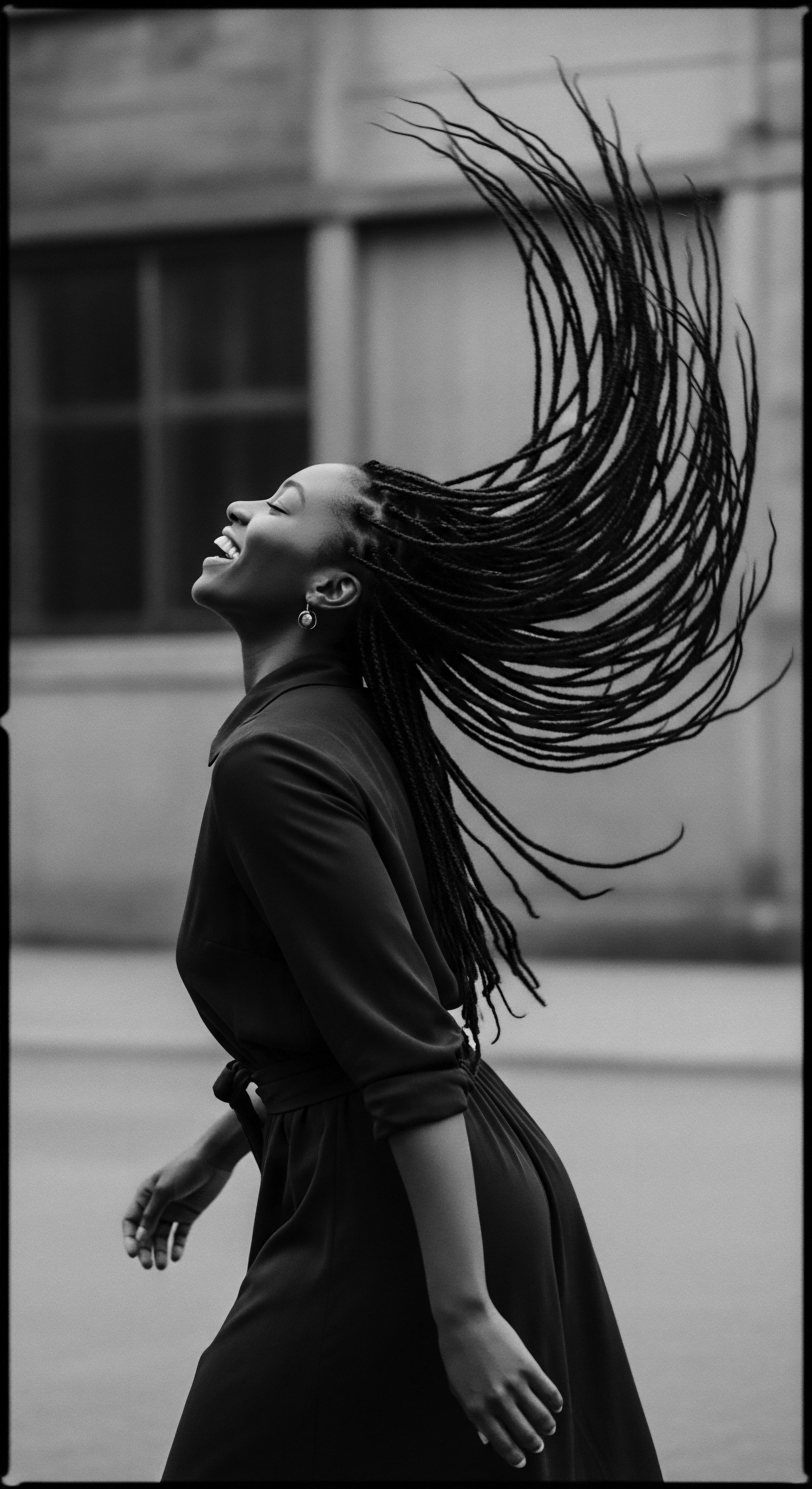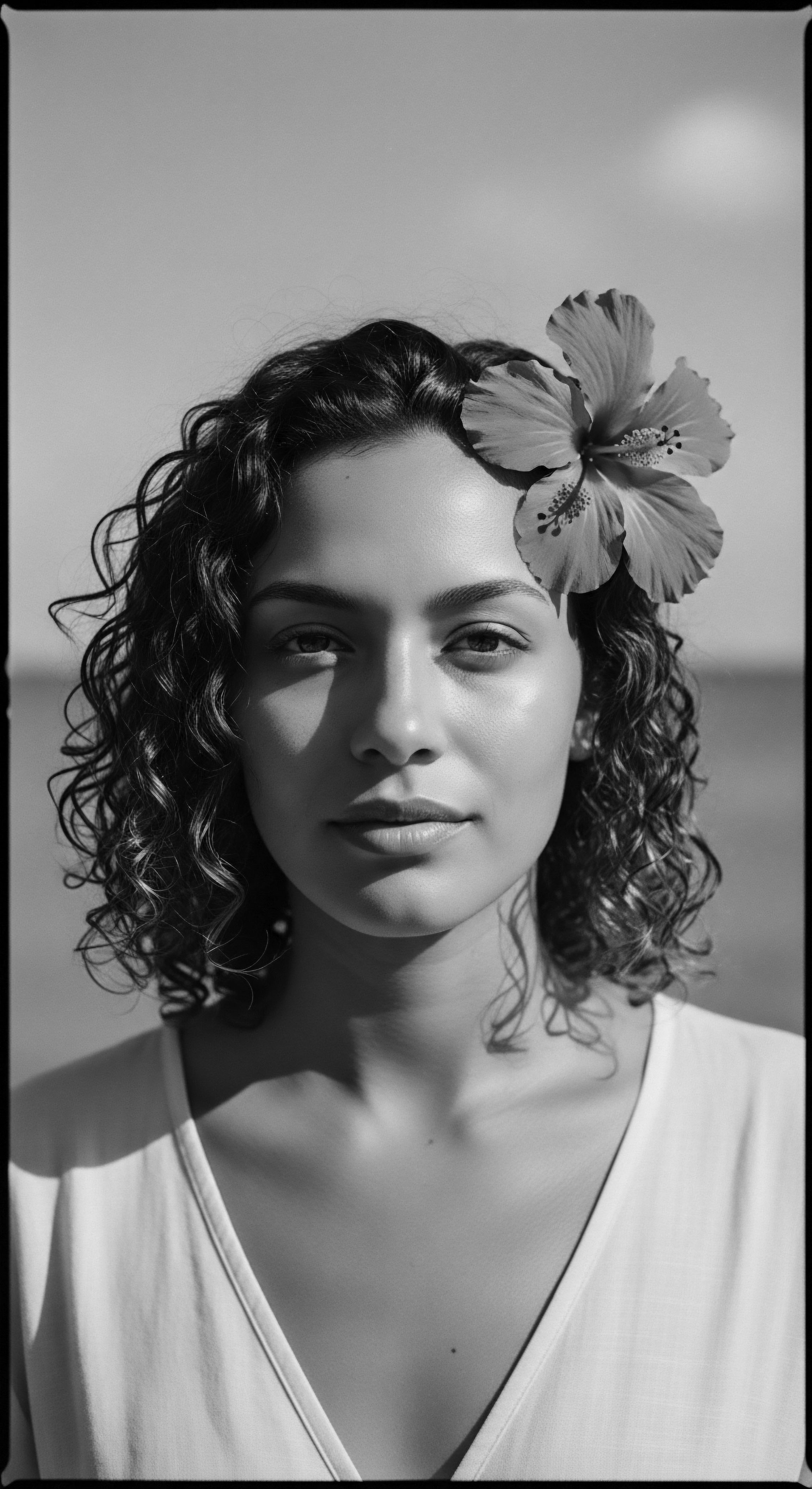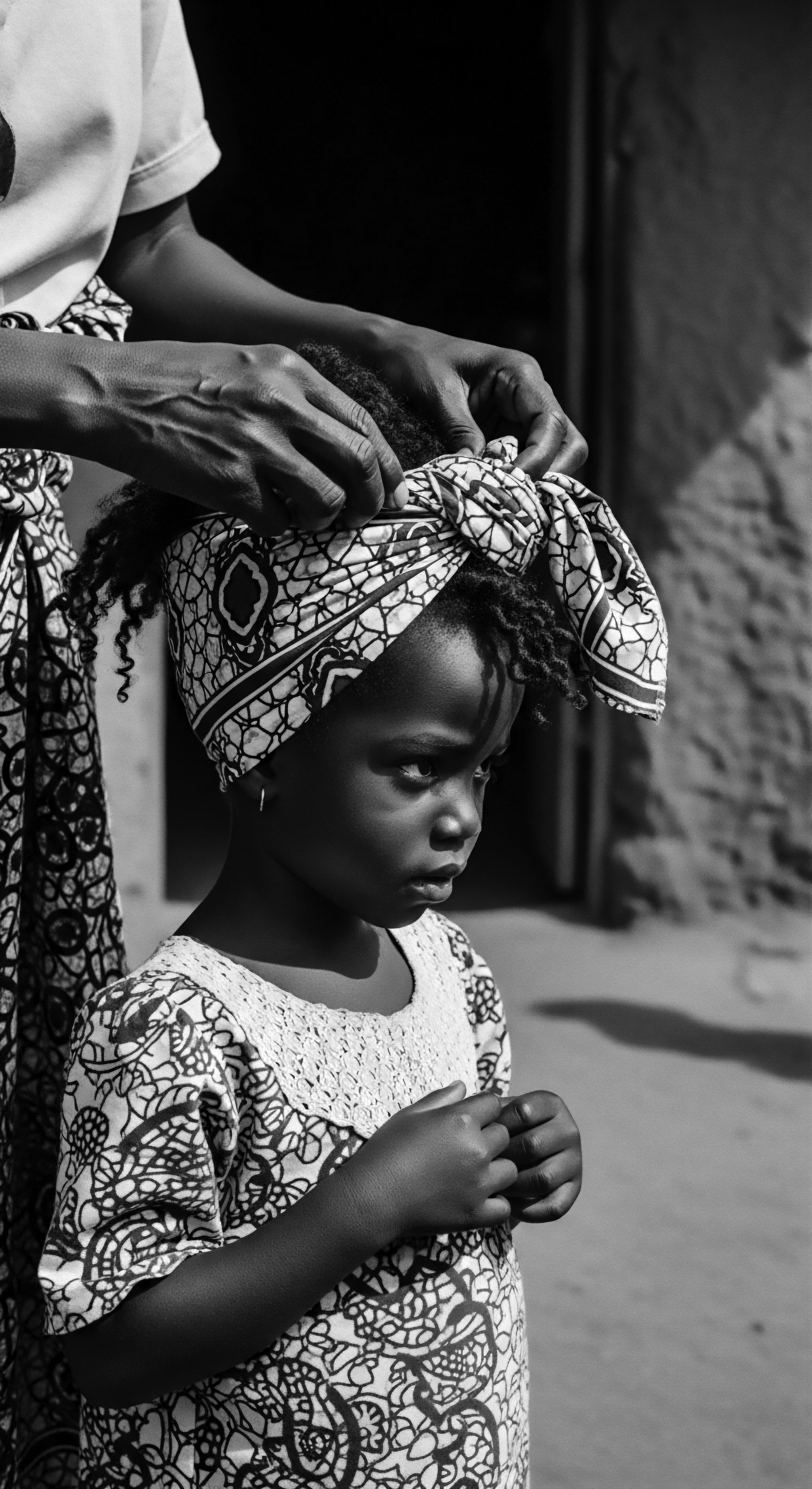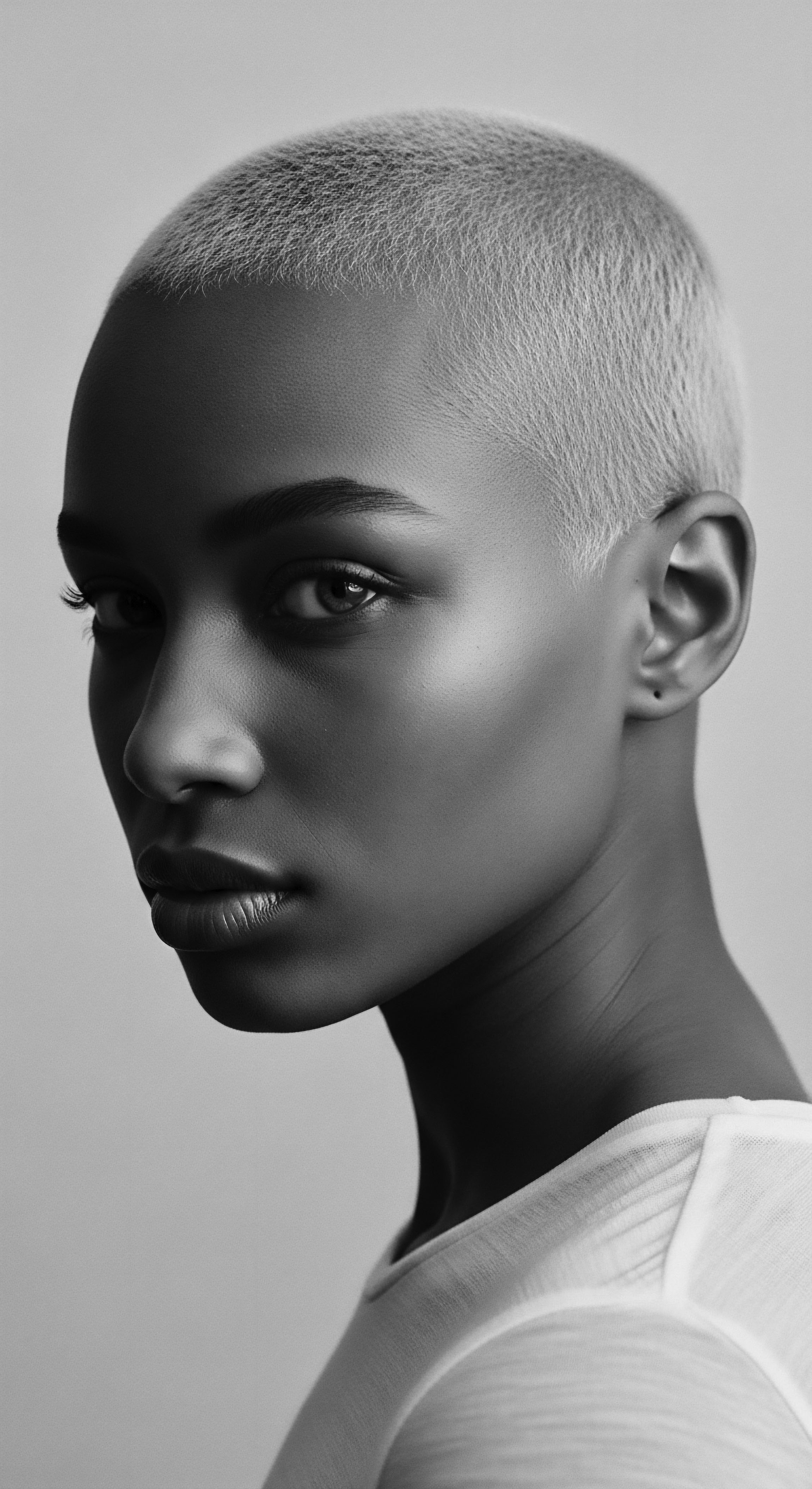
Roots
The coil and curl patterns of textured hair hold stories within their very structure, echoes of resilience passed down through generations. To speak of guarding this hair from dryness overnight is to speak of a heritage practice, a quiet revolution of care woven into the fabric of daily existence. It brings to mind the gentle hands of ancestors, applying what nature provided to protect and preserve strands that are, by their very design, prone to seeking moisture from the air around them. This exploration is an invitation, a journey into the heart of ancestral wisdom that shaped the understanding of textured hair and its needs, long before modern science offered its own lexicon.
Understanding the historical oils used for textured hair requires us to journey back to the elemental biology of hair itself. The intricate structure of a coiled strand, with its unique elliptical cross-section and often raised cuticle, allows moisture to escape more readily compared to straighter hair types. This inherent characteristic meant that ancestral communities, especially those in arid climates or with hair types that expressed significant curl, instinctively recognized the need for external emollients. The knowledge of which plants offered this deep moisture retention was not a fleeting trend; it was a survival skill, a cultural cornerstone passed through oral traditions and lived experience.

Textured Hair Anatomy and Its Ancestral Care
The physical makeup of textured hair, characterized by its varying degrees of curl and coil, plays a central role in its hydration needs. The bends and twists along the hair shaft create points where the cuticle, the outer protective layer, can lift. This lifted cuticle allows moisture to escape, contributing to dryness.
Generations ago, individuals observed this phenomenon with keen eyes, noting how certain applications minimized this moisture loss, particularly during periods of rest when the hair might be exposed to drying air. This observation laid the groundwork for sophisticated care routines.
Ancient communities, particularly across Africa and the African diaspora, recognized the unique challenges posed by hair that readily loses moisture. They learned to work in harmony with the hair’s natural inclination, not against it. This ancient wisdom, rooted in empirical observation, forms the basis of many modern hair care principles. The very word “care” in these contexts often carried a holistic meaning, connecting the vitality of hair to the overall well-being of the individual and their spiritual connection to the land.

What Did Ancient Peoples Understand About Hair Biology?
Though lacking microscopes, ancient peoples possessed a deep, intuitive grasp of hair biology derived from centuries of practical application. They understood that healthy hair was soft, pliable, and retained its luster. When hair became dry, brittle, or difficult to manage, they sought solutions from their natural environment. Their knowledge was not theoretical; it was an applied science, a living archive of remedies and practices.
This understanding extended to how different oils and butters interacted with the hair, some offering a lightweight sheen, others providing a heavier shield against dehydration. This discerning use of natural resources was a hallmark of their sophisticated approach to bodily care.
Ancestral communities understood that retaining moisture was paramount for textured hair, translating observational knowledge into timeless care practices.

Native Oils in Heritage Hair Care
The selection of oils for overnight hair care was intrinsically linked to the bioregions where communities lived. Across West Africa, for example, the shea tree yielded its prized butter, a rich, semi-solid fat known for its exceptional emollient properties. Shea Butter, or karité, became a staple for moisturizing both skin and hair, its use extending back at least 3,500 years. Its prevalence in hair care routines in these regions stemmed from its ability to coat the hair shaft, effectively sealing in moisture and guarding against the drying effects of the environment.
In other tropical zones, particularly in parts of Africa, the Caribbean, and Southeast Asia, Coconut Oil was a ubiquitous presence. This oil, extracted from the meat of coconuts, possesses a unique molecular structure, including a high content of lauric acid, which allows it to penetrate the hair shaft, thereby reducing protein loss and offering deep conditioning. Its light texture yet powerful moisturizing capability made it ideal for regular application, often before bed, to maintain softness and pliability through the night.
Another ancestral stalwart, particularly across African and Caribbean communities, was Castor Oil. Thick and viscous, castor oil, known in Haitian Creole as lwil maskrit, has a history in Haiti dating back to 1625, predating even Jamaican Black Castor Oil’s widely recognized use. Its density made it an exceptional sealant, creating a barrier that locked in moisture for prolonged periods. For textured hair, this meant sustained hydration, offering protection against dryness that could lead to breakage, especially during sleep when hair could rub against surfaces.
- Shea Butter ❉ From West and Central Africa, revered as “women’s gold,” utilized for centuries for its moisturizing and protective qualities due to its rich vitamin A and E content.
- Coconut Oil ❉ A cornerstone in Southeast Asian, South Asian, and tropical African communities, valued for its deep penetration and ability to reduce protein loss, used for thousands of years.
- Castor Oil ❉ With roots in ancient Egypt and Africa, carried to the Caribbean during the slave trade, becoming a staple for its thick, sealing properties and ability to stimulate scalp circulation.
- Olive Oil ❉ A Mediterranean elixir, used by ancient Greeks and Egyptians for thousands of years for its rich fatty acids, antioxidants, and vitamin E, providing nourishment and guarding against dryness.
- Jojoba Oil ❉ Originated with Indigenous American cultures, later adopted by Black communities for its similarity to natural sebum, offering balanced hydration without greasiness.

Ritual
The application of oils to textured hair, particularly for overnight moisture retention, was rarely a solitary act; it was often a deeply rooted ritual, a tender thread connecting individuals to their heritage, community, and the rhythms of nature. These practices were not just about hygiene or superficial beauty; they were acts of reverence for the self, for one’s lineage, and for the life force embodied in the strands themselves. The rhythm of these routines, often performed in the evenings, spoke to a deliberate preparation for rest and renewal.
In many Black and mixed-race communities across the diaspora, hair care rituals carried profound cultural weight. They were moments of intergenerational knowledge transfer, where grandmothers and mothers shared not only techniques but also stories, wisdom, and songs with younger hands. These sessions, especially nighttime oiling and styling, provided a sanctuary, a quiet space for connection and the passing of traditions. The choice of oil, the method of application, and the subsequent protective styling all held significance, contributing to a holistic approach to hair health that extended beyond mere physical attributes.

Preparing Hair for Nighttime Preservation
The efficacy of historical oils in guarding against overnight dryness was deeply intertwined with the preparation of the hair before application. It was understood that simply slathering oil onto dry, unmanaged hair would not yield optimal results. Instead, a thoughtful preparation preceded the application of the oil. This often involved gently detangling the hair, separating it into sections, or braiding it.
These actions minimized friction and tangling during sleep, preventing the hair from absorbing moisture from the pillowcase or becoming matted. The oils then worked as a protective shield, sealing in whatever moisture the hair held, or delivering hydration itself, while the structured style further aided preservation.
For instance, in many West African traditions, hair would be meticulously braided or twisted after oil application. These styles, such as cornrows or individual plaits, were not only aesthetically pleasing but also served as a highly effective protective measure. They kept the hair elongated and contained, reducing exposure to the elements and limiting opportunities for moisture loss.
The Himba tribe of Namibia, for example, coats their hair with otjize, a paste of ochre and butterfat, then styles it into thick braids, protecting it from sun and insects, a clear example of historical protective application. The Basara women of Chad apply their “Chebe” mixture, an herb-infused raw oil and animal fat, to their hair and braid it to maintain length, a practice extending over millennia.
| Practice Oiling and Massaging Scalp |
| Traditional Context Common in Ayurvedic traditions (India), West Africa, and parts of the Caribbean; often a bonding ritual. |
| Benefit for Overnight Hair Protection Circulation stimulation, direct moisture delivery to scalp and roots, reduction of dryness leading to itching. |
| Practice Sectioning Hair |
| Traditional Context Widely practiced across African and diasporic communities to manage dense, textured hair for easier care. |
| Benefit for Overnight Hair Protection Minimizes tangling, allows for even oil distribution, reduces friction and breakage during sleep. |
| Practice Protective Braiding or Twisting |
| Traditional Context Ancient practice in many African cultures (cornrows, plaits), sustained across the diaspora. |
| Benefit for Overnight Hair Protection Contains hair, prevents excessive moisture loss, maintains style, reduces manipulation and environmental exposure. |
| Practice Head Wraps and Bonnets |
| Traditional Context Historical attire in African regions (dukus, doek), adapted and used in the African American community for hair preservation. |
| Benefit for Overnight Hair Protection Creates a physical barrier against friction from pillows, traps warmth and moisture, maintains style integrity. |
| Practice These ancestral techniques, combined with carefully chosen oils, formed a comprehensive system for preserving textured hair's moisture and health. |

How Were Oils Applied for Nighttime Use?
The specific methods of oil application varied by culture and by the oil itself, but a common thread involved working the oil directly into the hair and scalp. For lighter oils, a generous coating might be applied, smoothed down the hair shaft from root to tip. For denser butters like shea, they were often warmed slightly by hand to melt, making them easier to distribute through the coils.
These applications were sometimes performed with the fingers, allowing for a tactile connection to the hair. Other times, natural tools, like wide-toothed combs crafted from wood, were used to gently separate the strands and ensure even coverage.
Nighttime oiling was more than maintenance; it was a conversation between generations, a silent vow to uphold the integrity of the strand.
The ritual often concluded with the hair being wrapped or covered. Headwraps, known as dukus or doek in African countries, have been traditional attire for centuries, reflecting wealth, ethnicity, and marital status, but also serving the practical purpose of hair protection. Bonnets, or “sleep caps,” similarly, have a rich history, with European women wearing them in the mid-1800s to keep hair tangle-free, a practice that gained immense cultural significance in the African American community, especially post-slavery, as a means of hair preservation and resistance against oppression. These coverings acted as a protective envelope, minimizing friction against rough sleeping surfaces and further sealing in the applied oils, allowing them to work their magic undisturbed.

Cultural Variations in Nighttime Hair Oiling
The tapestry of historical hair care is rich with regional variations, each reflecting the unique environment, available botanical resources, and cultural nuances of a people. While the core purpose of guarding against dryness remained, the specific oils and methods adapted to local contexts.
- In parts of the Caribbean, particularly Haiti, the tradition of using Haitian Black Castor Oil (lwil maskrit) for nightly application speaks to a deep ancestral reliance on local resources for hair health and growth. This practice, passed down through generations, allowed for sustained moisture in humid yet often harsh climates.
- Across various Indigenous American cultures, Jojoba Oil was used as a balm for hair, skin, and even minor wounds. Its resemblance to the scalp’s natural sebum made it a natural choice for hydration, preventing dryness without heaviness, a practice well-suited for overnight protection in drier desert environments.
- The ancient Egyptians, known for their elaborate beauty routines, used a range of plant-derived oils, including Castor Oil and Moringa Oil, for both hair growth and shine. Though specific “overnight dryness” rituals are less documented than daily anointing, the general use of these emollients would have naturally extended to continuous hair preservation, especially considering the wigs and intricate styles that needed protection.

Relay
The ancestral wisdom concerning historical oils and their role in preserving textured hair from overnight dryness carries profound implications for our contemporary understanding. This knowledge is not merely a collection of antiquated remedies; it represents a sophisticated, empirically derived science, honed over millennia. It speaks to a deep ecological literacy, a connection to the earth’s bounty that modern science often strives to replicate. To understand these practices is to recognize the inherent scientific principles that underpinned traditional care, confirming their authority and value.
Textured hair, with its unique structural characteristics, inherently seeks hydration. The historical response to this need, particularly for overnight protection, was driven by a practical imperative ❉ preserving moisture to prevent breakage and maintain pliability. This objective remains central to textured hair care today.
The continuity of these practices, even through immense historical upheaval and cultural displacement, speaks to their efficacy and the resilience of those who upheld them. The story of these oils is a narrative of adaptation, survival, and the persistent power of heritage.

How Did These Oils Guard Against Overnight Moisture Loss?
The effectiveness of historical oils in preventing overnight dryness in textured hair can be explained by their varying properties, which essentially worked in concert to create a robust moisture barrier.
First, certain oils function as powerful occlusives. Shea Butter, for example, is a rich emollient that creates a protective film on the hair shaft. This film slows the rate of water evaporation from the hair, acting as a physical barrier against dry air and friction from bedding.
The denseness of Castor Oil lends itself to a similar occlusive action, effectively sealing in moisture and providing a heavy coat that can withstand overnight movement. This “sealing” property was a primary defense against desiccation.
Second, some oils possess humectant or conditioning properties, attracting and holding moisture, or simply conditioning the hair shaft itself. While few oils are true humectants (attracting water from the air), many function as conditioning agents that smooth the cuticle, thereby reducing the surface area through which water can escape. Oils like Coconut Oil, with its lauric acid, are known to penetrate the hair shaft, reducing protein loss and providing internal moisture support.
Olive Oil, rich in monounsaturated fats and antioxidants, similarly works to nourish and condition the hair, helping to maintain its softness and integrity overnight. These properties, combined with protective styles, created a comprehensive shield.
Beyond the chemical composition, the physical act of applying these oils and then employing protective styles or coverings (such as braids, twists, or head wraps) created an optimal environment for moisture retention. This combination reduced friction, minimized exposure to drying air, and maintained the hair’s coiled structure, which is vital for its inherent strength.
The genius of ancestral hair care lay in the strategic use of oils and protective styling to create a nocturnal sanctuary for textured hair.

Less Commonly Explored Historical Examples
While many familiar oils hold deep historical roots, the scope of ancestral hair care extends to practices that, though perhaps less globally commercialized today, are equally profound in their heritage significance. Consider the tradition of using particular animal fats in conjunction with plant extracts in certain African communities. The Basara people of Chad, for instance, are known for their Chebe powder, a mixture of herbs often combined with oils or animal fats, applied to the hair and braided to maintain exceptional length retention. This practice, dating back millennia, provides intense moisture and protection, creating a sealed environment for the hair.
Another example comes from communities in Ethiopia and Somalia, where a homemade “hair butter” created from whipped animal milk (ghee or clarified butter) mixed with water was used for hair maintenance. This rich, lipid-based application speaks to an ingenious use of available resources to address the hair’s moisture needs, particularly in regions where dryness could be a significant challenge. These practices, though varied, share a common thread ❉ an intuitive understanding of emollients to guard against nightly dehydration.
| Oil/Butter Shea Butter |
| Primary Fatty Acids/Components Stearic, Oleic, Palmitic, Linoleic acids; Vitamins A, E, F. |
| Mechanism of Overnight Protection (Traditional Understanding & Modern Science) Forms a substantial occlusive barrier on the hair surface, preventing moisture escape and acting as a physical shield against friction. Reduces transepidermal water loss. |
| Oil/Butter Coconut Oil |
| Primary Fatty Acids/Components Lauric acid (high content), Myristic, Palmitic acids. |
| Mechanism of Overnight Protection (Traditional Understanding & Modern Science) Low molecular weight and linear structure allow for penetration into the hair shaft, reducing protein loss and providing internal conditioning. Creates a hydrophobic layer externally. |
| Oil/Butter Castor Oil |
| Primary Fatty Acids/Components Ricinoleic acid (dominant, 85-95%), Oleic, Linoleic acids. |
| Mechanism of Overnight Protection (Traditional Understanding & Modern Science) Extremely viscous, forming a thick sealing layer that traps moisture effectively and coats the hair strand, increasing pliability. |
| Oil/Butter Olive Oil |
| Primary Fatty Acids/Components Oleic acid (high content), Palmitic, Linoleic acids; Vitamin E, antioxidants. |
| Mechanism of Overnight Protection (Traditional Understanding & Modern Science) Coats the hair, smoothing the cuticle and reducing moisture evaporation. Its conditioning properties help maintain hair elasticity. |
| Oil/Butter Jojoba Oil |
| Primary Fatty Acids/Components Liquid wax esters, resembling human sebum. |
| Mechanism of Overnight Protection (Traditional Understanding & Modern Science) Mimics natural scalp oils, conditioning the hair without greasiness. Sits on the outside of strands to lock in moisture, reducing breakage. |
| Oil/Butter These oils, through diverse chemical structures, served the singular ancestral purpose of moisture retention, a testament to practical botanical wisdom. |

How Does Understanding Ancestral Practices Inform Modern Care?
The deep historical roots of hair oiling offer invaluable lessons for contemporary textured hair care. They highlight the enduring importance of moisture retention as a foundational principle. Modern product formulations often aim to replicate the protective and conditioning benefits of these historical oils, albeit with refined processes and sometimes synthetic additives. However, the ancestral approach reminds us that often, simplicity and natural resources offer potent solutions.
A particularly illuminating example of this ancestral wisdom’s lasting power is the continued global popularity of Jamaican Black Castor Oil (JBCO). Originating from the castor plant brought to Jamaica during the transatlantic slave trade, JBCO has become a cornerstone of hair care in the African American community and beyond. Its traditional processing involves roasting the beans longer, yielding a darker oil with higher ash content, which is believed to amplify its effectiveness for strengthening, moisturizing, and promoting hair growth.
The use of JBCO for growth and to combat dryness in coiled hair has surged, a powerful testament to a time-honored ritual proving its worth in a modern context. It encapsulates how a historical practice, born of necessity and passed through generations, continues to resonate, its effectiveness validated by the lived experience of countless individuals seeking to protect their textured strands overnight.
The ongoing practice of protecting hair at night, often with bonnets or silk scarves, is a direct inheritance from these ancestral traditions. These coverings, whether the “dukus” of Ghana or the practical wraps of enslaved women in the Americas, served to shield hair from friction, maintain styles, and conserve moisture. This lineage underscores that successful hair care is not just about what is applied, but how it is protected, especially during the hours of sleep when hair is most vulnerable to mechanical stress and environmental dryness. The ingenuity of these historical solutions speaks volumes, reminding us that the wisdom of our ancestors often holds keys to lasting well-being.

Reflection
The journey into what historical oils guarded textured hair from dryness overnight reveals a profound truth ❉ the care of textured hair has always been a testament to human ingenuity, cultural resilience, and an intimate dialogue with the natural world. From the sun-baked savannas where shea trees stood as sentinels of moisture, to the lush tropical islands where the coconut reigned supreme, our ancestors did not merely tend to their hair; they honored it. These practices were not just about aesthetics; they were about preserving strength, maintaining health, and upholding a tangible connection to identity and heritage.
The quiet ritual of applying oil before sleep, a practice passed down through generations, embodies the ‘Soul of a Strand’ ethos. It speaks of a deep understanding that the life of a coiled strand continues even as the body rests, and that diligent protection in those nocturnal hours contributes to its vitality. The historical oils, whether shea, coconut, castor, or olive, acted as gentle guardians, their properties recognized and applied with an ancestral wisdom that modern science now unpacks and admires. This living archive of hair care reminds us that our hair is more than fiber; it is a repository of stories, a living lineage that asks for reverence and understanding, a legacy woven into every coil.

References
- Bebrų Kosmetika. (2024). The Power of Hair in African Folklore ❉ Rituals and Traditions.
- Kedi, C. (2017). Beautifying the Body in Ancient Africa and Today. Books of Africa.
- Byrdie. (2022). The History of Headwraps.
- Byrdie. (2022). The Significance and History of Bonnets.
- Cécred. (2025). Understanding Hair Oiling ❉ History, Benefits & More.
- Essence. (2020). The Truth About Castor Oil on Natural Hair.
- Fabulive. (2023). Rediscovering Historical Hair Care Practices.
- Garnier. (n.d.). The ancient powers and benefits of olive oil for hair.
- Hairborist. (n.d.). Jojoba oil for hair ❉ The extraordinary benefits & uses.
- Helix Hair Labs. (2023). THE HISTORY OF THE HAIR BONNET.
- Italianraw. (n.d.). AN ANCIENT INGREDIENT FOR BEAUTY ❉ OLIVE OIL.
- Kuza Products. (2023). 7 Benefits of Jamaican Black Castor Oil on Hair.
- Naturally Curly. (n.d.). Haitian Black Castor Oil.
- Orifera. (2024). The History of Coconut Oil and Its Cultural Significance Across the World.
- Sellox Blog. (2021). Ancient African Hair Growth Secrets For Healthy Hair.
- sheabutter.net. (n.d.). A History of Shea Butter.
- Sunny Isle Jamaican Black Castor Oil. (n.d.). About Us.
- Thought Co. (2020). What Is the History of Olive Oil?
